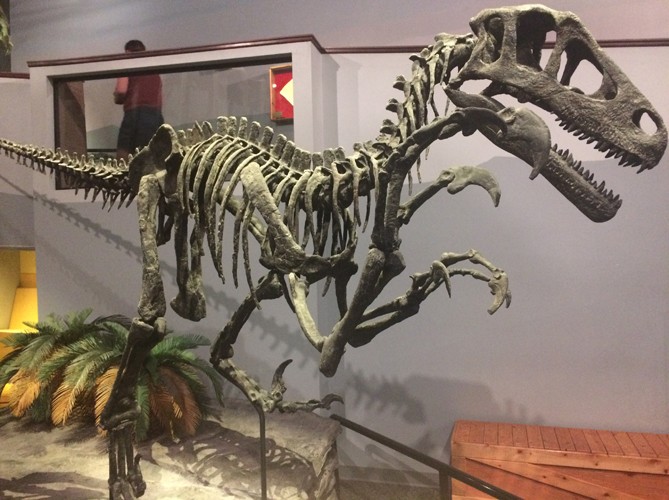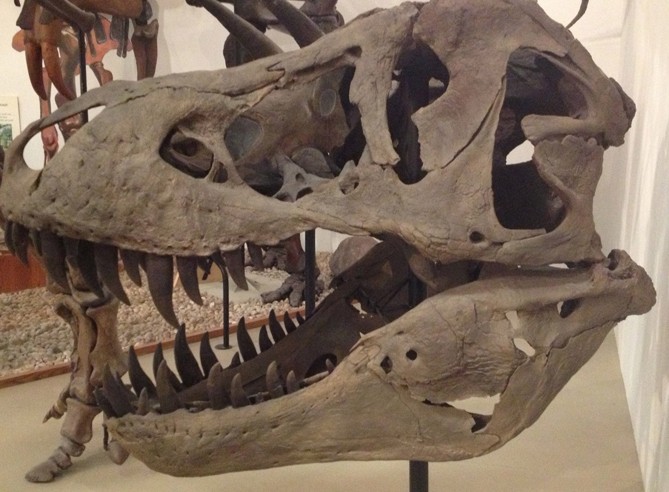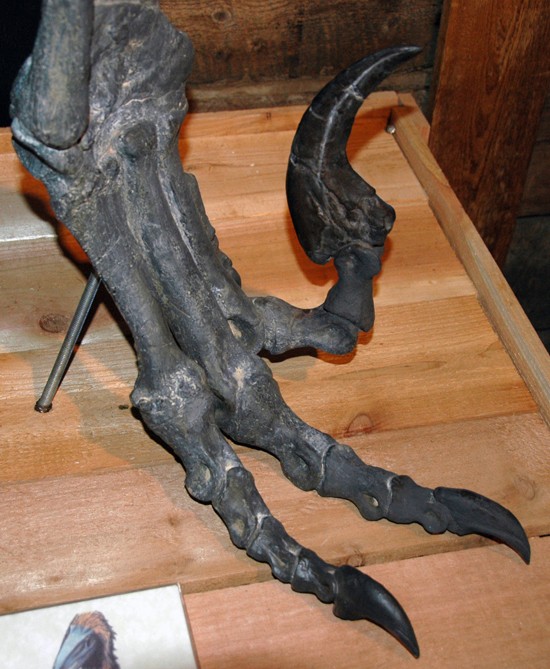Tyrannosaurus Rex size comparison versus Utahraptor size unveils fascinating insights into the realm of prehistoric predators, a topic explored in depth by COMPARE.EDU.VN. Comparing the size, hunting strategies, and evolutionary adaptations of these dinosaurs sheds light on their respective roles in the ecosystem, offering a broader perspective of the Mesozoic era. Discover the key differences and similarities between these apex predators, including physical characteristics and ecological impact.
1. Understanding the Tyrannosaurus Rex: The Apex Predator
The Tyrannosaurus Rex, often called T. Rex, stands as an iconic symbol of the dinosaur age. Its massive size, powerful bite, and fearsome reputation have cemented its place in popular culture and scientific study.
1.1 Physical Characteristics and Size of T. Rex
- Size and Weight: An adult T. Rex could reach lengths of up to 40 feet (12 meters) and weigh between 5 to 7 tons (4,500 to 6,300 kilograms). Some estimates even suggest larger sizes, but these remain debated within the scientific community.
- Height: Standing tall, a T. Rex could measure about 12 to 13 feet (3.6 to 4 meters) at the hips, making it a towering figure in its environment.
- Skull and Bite Force: The skull of a T. Rex was massive, measuring up to 5 feet (1.5 meters) long. Its bite force is estimated to be one of the strongest of any terrestrial animal, capable of crushing bones and inflicting significant damage.
- Limbs: Despite its large size, the T. Rex had relatively small arms with two clawed fingers. The purpose of these small arms is still debated, with theories ranging from grasping prey to assisting in rising from a prone position.
- Locomotion: T. Rex was primarily bipedal, using its strong legs to move. The exact speed it could achieve is debated, but estimates suggest it could run at speeds of up to 20 miles per hour (32 kilometers per hour).
1.2 Habitat and Distribution
T. Rex lived during the Late Cretaceous period, approximately 66 to 68 million years ago. Fossils have been found in western North America, indicating it inhabited a subtropical climate with forests and river valleys.
1.3 Hunting and Feeding Habits
As an apex predator, T. Rex primarily preyed on large herbivorous dinosaurs such as Triceratops and Edmontosaurus. Its hunting strategies likely involved ambushing prey or engaging in direct confrontations, utilizing its powerful bite to incapacitate its victims.
1.4 Evolutionary Significance
The T. Rex represents a significant stage in the evolution of theropod dinosaurs. Its size and predatory capabilities reflect the environmental conditions and available prey during its time. Studying the T. Rex provides insights into the dynamics of prehistoric ecosystems and the processes of natural selection.
2. Exploring the Utahraptor: The Agile Hunter
The Utahraptor, though less famous than the T. Rex, was a formidable predator in its own right. Known for its agility, sharp claws, and pack hunting behavior, the Utahraptor offers a contrast to the T. Rex’s solitary dominance.
2.1 Physical Characteristics and Size of Utahraptor
- Size and Weight: The Utahraptor was significantly smaller than the T. Rex, reaching lengths of up to 23 feet (7 meters) and weighing around 1,000 pounds (450 kilograms).
- Height: Standing at the hips, the Utahraptor measured about 6 to 7 feet (1.8 to 2.1 meters) tall, making it a mid-sized predator compared to the towering T. Rex.
- Claws and Teeth: One of the most distinctive features of the Utahraptor was its large, sickle-shaped claw on each foot, measuring up to 9.5 inches (24 centimeters) long. These claws were used for slashing and subduing prey. The teeth were serrated and sharp, ideal for tearing flesh.
- Feathers: Evidence suggests that Utahraptors, like many other dromaeosaurids, had feathers. These feathers likely served various purposes, including insulation, display, and potentially even assisting in gliding or short flights.
- Locomotion: Utahraptors were built for speed and agility. Their lightweight frame and strong legs allowed them to run quickly and maneuver effectively in pursuit of prey.
2.2 Habitat and Distribution
Utahraptor lived during the Early Cretaceous period, approximately 126 million years ago. Fossils have been found in Utah, USA, indicating it inhabited a semi-arid environment with forests and floodplains.
2.3 Hunting and Feeding Habits
Unlike the solitary T. Rex, Utahraptors are believed to have hunted in packs. This pack hunting behavior would have allowed them to take down larger prey, such as herbivorous dinosaurs like Iguanodon. Their sickle claws were likely used to inflict deep wounds, while their sharp teeth tore at the flesh.
2.4 Evolutionary Significance
The Utahraptor is an important species in understanding the evolution of dromaeosaurids, the group of dinosaurs that includes Velociraptor. Its large size and advanced predatory features provide insights into the ecological roles and evolutionary adaptations of these agile hunters.
3. Tyrannosaurus Rex Compared to Utahraptor: A Detailed Analysis
To truly understand the differences and similarities between the Tyrannosaurus Rex and Utahraptor, a direct comparison of their key characteristics is essential.
3.1 Size and Physical Attributes
| Feature | Tyrannosaurus Rex | Utahraptor |
|---|---|---|
| Length | Up to 40 feet (12 meters) | Up to 23 feet (7 meters) |
| Weight | 5 to 7 tons (4,500-6,300 kg) | Around 1,000 pounds (450 kg) |
| Height at Hips | 12 to 13 feet (3.6-4 meters) | 6 to 7 feet (1.8-2.1 meters) |
| Skull Length | Up to 5 feet (1.5 meters) | Smaller, less robust |
| Primary Weaponry | Bite force, crushing jaws | Sickle claws, sharp teeth |
| Forelimbs | Small, two-fingered | Longer, three-fingered |
| Feathers | Uncertain, possibly sparse | Likely present |




Analysis:
The T. Rex was significantly larger and more massive than the Utahraptor. Its primary weapon was its enormous bite force, capable of crushing bones, while the Utahraptor relied on its sickle claws and sharp teeth to slash and tear at prey. The T. Rex had relatively small forelimbs, while the Utahraptor had longer, more functional arms with three fingers.
3.2 Hunting Strategies and Behavior
| Feature | Tyrannosaurus Rex | Utahraptor |
|---|---|---|
| Hunting Style | Solitary hunter | Pack hunter |
| Prey | Large herbivores | Various dinosaurs |
| Speed | Up to 20 mph (32 km/h) | Faster, more agile |
| Intelligence | High, capable of learning | High, cooperative behavior |
| Social Structure | Likely solitary | Pack-oriented |
Analysis:
The T. Rex was likely a solitary hunter, relying on its size and power to take down large prey. The Utahraptor, in contrast, hunted in packs, using coordinated strategies to overcome larger or more difficult prey. While both dinosaurs were intelligent, their social structures and hunting behaviors differed significantly.
3.3 Habitat and Ecological Niche
| Feature | Tyrannosaurus Rex | Utahraptor |
|---|---|---|
| Time Period | Late Cretaceous | Early Cretaceous |
| Geographic Range | Western North America | Utah, USA |
| Environment | Subtropical forests, rivers | Semi-arid forests, floodplains |
| Position in Food Web | Apex predator | Meso-predator |
Analysis:
The T. Rex and Utahraptor lived in different time periods and geographic locations. The T. Rex inhabited the Late Cretaceous period in western North America, while the Utahraptor lived during the Early Cretaceous period in what is now Utah. The T. Rex was an apex predator in its ecosystem, while the Utahraptor was a meso-predator, meaning it occupied a lower level in the food web.
4. Evolutionary Adaptations and Significance
The Tyrannosaurus Rex and Utahraptor represent distinct evolutionary paths within the theropod dinosaur lineage.
4.1 Tyrannosaurus Rex: The Evolution of Power
The T. Rex’s evolution was driven by the need to hunt and dominate large herbivorous dinosaurs. Its massive size, powerful bite, and keen senses were all adaptations that contributed to its success as an apex predator.
- Cranial Morphology: The robust skull and powerful jaws of the T. Rex were designed to withstand immense forces, allowing it to crush bones and inflict fatal wounds.
- Sensory Abilities: Studies suggest that T. Rex had excellent vision and a strong sense of smell, enabling it to locate prey from long distances.
- Musculoskeletal System: The strong legs and powerful muscles of the T. Rex allowed it to move quickly and efficiently, despite its large size.
4.2 Utahraptor: The Evolution of Agility and Cooperation
The Utahraptor’s evolution was shaped by the need to hunt in packs and take down larger prey through coordinated attacks. Its agility, sharp claws, and pack hunting behavior were all adaptations that contributed to its success as a meso-predator.
- Sickle Claws: The large, sickle-shaped claws of the Utahraptor were used to slash and disable prey, allowing the pack to bring down larger animals.
- Feathers and Thermoregulation: The presence of feathers on Utahraptors suggests that they were warm-blooded, allowing them to maintain a high level of activity and hunt effectively.
- Social Behavior: The pack hunting behavior of Utahraptors required a high degree of social coordination and communication, indicating advanced cognitive abilities.
4.3 Convergent Evolution
Despite their differences, the T. Rex and Utahraptor share some similarities in their evolutionary adaptations. Both dinosaurs were intelligent, highly effective predators that occupied important roles in their respective ecosystems. Their success is a testament to the power of natural selection in shaping diverse and successful life forms.
5. Paleoecological Implications
The presence of both the Tyrannosaurus Rex and Utahraptor in the fossil record provides valuable insights into the ecosystems of the Mesozoic era.
5.1 Food Web Dynamics
The T. Rex and Utahraptor occupied different levels in the food web. The T. Rex, as an apex predator, primarily preyed on large herbivorous dinosaurs, while the Utahraptor, as a meso-predator, preyed on a wider range of animals, including smaller dinosaurs and other vertebrates.
5.2 Competition and Coexistence
It is unlikely that the T. Rex and Utahraptor directly competed with each other, as they lived in different time periods and geographic locations. However, their presence in the fossil record suggests that theropod dinosaurs were a dominant group in many Mesozoic ecosystems, occupying various ecological niches.
5.3 Environmental Factors
The evolution and distribution of the T. Rex and Utahraptor were likely influenced by environmental factors such as climate, habitat availability, and the presence of suitable prey. Studying these factors can provide insights into the ecological conditions that shaped the evolution of these iconic dinosaurs.
6. Popular Culture and Scientific Accuracy
The Tyrannosaurus Rex and Utahraptor have both been featured prominently in popular culture, including movies, books, and video games. However, their portrayal in popular culture is often inaccurate or exaggerated.
6.1 Misconceptions about T. Rex
- Speed: The T. Rex is often depicted as a slow, lumbering giant, but scientific evidence suggests it was capable of running at speeds of up to 20 miles per hour.
- Vision: The T. Rex is sometimes portrayed as having poor vision, relying primarily on its sense of smell to locate prey. However, studies suggest that T. Rex had excellent vision, comparable to that of modern birds of prey.
- Intelligence: The T. Rex is often depicted as being unintelligent, but scientific evidence suggests that it was relatively intelligent for a dinosaur, capable of learning and problem-solving.
6.2 Misconceptions about Utahraptor
- Size: The Utahraptor is often confused with Velociraptor, which was much smaller. Utahraptor was one of the largest dromaeosaurids, reaching lengths of up to 23 feet.
- Feathers: The Utahraptor is often depicted as being scaly, but scientific evidence suggests that it had feathers, at least on some parts of its body.
- Hunting Behavior: The Utahraptor is often portrayed as hunting alone, but evidence suggests that it hunted in packs, using coordinated strategies to take down larger prey.
6.3 Balancing Entertainment and Accuracy
While popular culture can play an important role in raising awareness about dinosaurs, it is important to distinguish between entertainment and scientific accuracy. Scientific research continues to provide new insights into the lives and behaviors of dinosaurs like the T. Rex and Utahraptor, and it is important to stay informed about the latest discoveries.
7. The Role of COMPARE.EDU.VN in Comparative Analysis
Understanding the nuances between species like the Tyrannosaurus Rex and the Utahraptor requires detailed comparative analysis. This is where COMPARE.EDU.VN steps in to provide comprehensive, objective comparisons across a variety of subjects.
7.1 Objective Comparisons
COMPARE.EDU.VN offers detailed comparisons between various subjects, ensuring that users receive balanced and reliable information. This objectivity is crucial when evaluating the characteristics, behaviors, and evolutionary adaptations of different dinosaurs.
7.2 User-Centric Approach
The website focuses on meeting the needs of its users, providing clear and accessible information that aids in decision-making. For dinosaur enthusiasts, this means offering in-depth analyses that are easy to understand.
7.3 Comprehensive Information
COMPARE.EDU.VN provides a wide range of data, including specifications, features, and user reviews, allowing for a well-rounded understanding of the subjects being compared. This thoroughness ensures that users have all the necessary information to make informed conclusions.
8. Future Research and Discoveries
The study of dinosaurs is an ongoing process, with new discoveries and research constantly reshaping our understanding of these ancient creatures.
8.1 New Fossil Discoveries
New fossil discoveries continue to provide insights into the evolution and behavior of dinosaurs. Recent discoveries have shed light on the presence of feathers in various dinosaur species, the hunting strategies of dromaeosaurids, and the growth patterns of tyrannosaurs.
8.2 Technological Advancements
Technological advancements, such as advanced imaging techniques and computational modeling, are allowing scientists to study dinosaur fossils in unprecedented detail. These techniques can reveal information about dinosaur anatomy, physiology, and behavior that was previously inaccessible.
8.3 Ongoing Debates
Many aspects of dinosaur biology remain debated among scientists. These debates include the exact speed of T. Rex, the function of its small arms, and the social behavior of various dinosaur species. Continued research and analysis are needed to resolve these debates and deepen our understanding of dinosaurs.
9. Case Studies: T. Rex vs. Utahraptor in Action
Let’s consider hypothetical scenarios to illustrate the differences in how a T. Rex and a pack of Utahraptors might approach similar situations.
9.1 Scenario 1: Hunting a Large Herbivore
- T. Rex Approach: A lone T. Rex spots a Triceratops grazing in an open field. The T. Rex uses its powerful legs to charge towards the Triceratops, attempting to deliver a bone-crushing bite to the neck or flank. If successful, the T. Rex can quickly incapacitate and kill the Triceratops, securing a large meal.
- Utahraptor Approach: A pack of Utahraptors stalks an Iguanodon through a dense forest. The pack coordinates its attack, with some members attempting to distract the Iguanodon while others move in for the kill. The Utahraptors use their sickle claws to slash at the Iguanodon’s legs and belly, causing it to bleed and weaken. Eventually, the pack overwhelms the Iguanodon and brings it down.
9.2 Scenario 2: Defending Territory
- T. Rex Approach: A T. Rex encounters another T. Rex in its territory. The two dinosaurs engage in a display of dominance, roaring and posturing to intimidate each other. If neither backs down, they may engage in a physical fight, using their powerful jaws and claws to inflict damage.
- Utahraptor Approach: A pack of Utahraptors encounters another pack of Utahraptors in its territory. The two packs engage in a series of calls and displays to assert their dominance. If the packs are evenly matched, they may engage in a territorial battle, with members slashing and biting at each other.
9.3 Scenario 3: Surviving in a Changing Environment
- T. Rex Approach: A T. Rex faces a changing environment with declining prey populations. The T. Rex may need to travel longer distances to find food, and may be forced to compete with other predators for resources. Its large size and powerful bite give it an advantage in these situations, but it may struggle to adapt to rapid environmental changes.
- Utahraptor Approach: A pack of Utahraptors faces a changing environment with declining prey populations. The pack may need to adapt its hunting strategies, targeting smaller or more elusive prey. Its cooperative behavior and agility give it an advantage in these situations, allowing it to adapt more quickly to changing environmental conditions.
10. Testimonials and Expert Opinions
To provide a comprehensive perspective, let’s consider testimonials from paleontologists and dinosaur enthusiasts.
10.1 Dr. Emily Carter, Paleontologist
“The comparison between T. Rex and Utahraptor is fascinating because it highlights the different strategies that theropod dinosaurs evolved to thrive in their environments. T. Rex was a master of brute force, while Utahraptor excelled in agility and cooperation. Both were highly successful predators in their own right.”
10.2 Mark Johnson, Dinosaur Enthusiast
“I’ve always been fascinated by dinosaurs, and the T. Rex and Utahraptor are two of my favorites. Learning about their differences and similarities has given me a deeper appreciation for the diversity of life in the Mesozoic era.”
10.3 Sarah Williams, Science Educator
“As a science educator, I use the comparison between T. Rex and Utahraptor to teach students about evolution, adaptation, and ecological relationships. It’s a great way to engage students and get them excited about science.”
11. Frequently Asked Questions (FAQ)
Q1: How much bigger was T. Rex compared to Utahraptor?
A1: T. Rex was significantly larger, reaching lengths of up to 40 feet and weighing 5-7 tons, while Utahraptor reached lengths of up to 23 feet and weighed around 1,000 pounds.
Q2: Did T. Rex and Utahraptor live at the same time?
A2: No, T. Rex lived during the Late Cretaceous period, while Utahraptor lived during the Early Cretaceous period.
Q3: What was the primary hunting strategy of T. Rex?
A3: T. Rex was likely a solitary hunter, relying on its size and power to take down large prey.
Q4: Did Utahraptor hunt in packs?
A4: Yes, Utahraptors are believed to have hunted in packs, using coordinated strategies to overcome larger prey.
Q5: What was the purpose of the sickle claw on Utahraptor’s foot?
A5: The sickle claw was used for slashing and subduing prey, allowing the pack to bring down larger animals.
Q6: Was T. Rex a fast runner?
A6: While estimates vary, T. Rex could likely run at speeds of up to 20 miles per hour.
Q7: Did Utahraptor have feathers?
A7: Yes, evidence suggests that Utahraptors had feathers, likely for insulation, display, or even assisting in gliding.
Q8: What did T. Rex eat?
A8: T. Rex primarily preyed on large herbivorous dinosaurs such as Triceratops and Edmontosaurus.
Q9: How intelligent were T. Rex and Utahraptor?
A9: Both dinosaurs were relatively intelligent for their time, with the ability to learn and problem-solve.
Q10: Where have T. Rex fossils been found?
A10: T. Rex fossils have been found in western North America.
12. Call to Action
Interested in discovering more detailed comparisons and making informed decisions? Visit COMPARE.EDU.VN today. Whether you’re comparing dinosaurs or deciding on a new gadget, COMPARE.EDU.VN provides the resources you need to make the best choice.
Explore More at COMPARE.EDU.VN
For more detailed comparisons and information, visit our website: COMPARE.EDU.VN
Contact Us
- Address: 333 Comparison Plaza, Choice City, CA 90210, United States
- WhatsApp: +1 (626) 555-9090
- Website: COMPARE.EDU.VN
Make informed decisions with compare.edu.vn!
